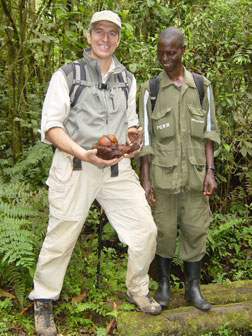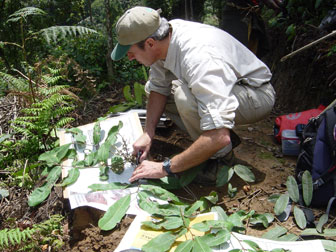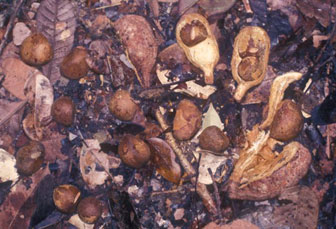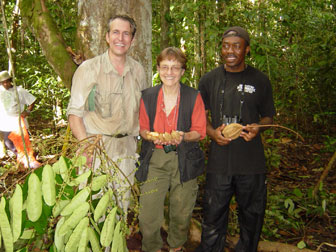France needs to act to protect French Guiana’s rainforests
An interview with rainforest plant expert Pierre-Michel Forget:
France needs to act to protect French Guiana’s rainforests
mongabay.com
December 19, 2006
Understanding relationships between plants and animals is key to understanding rainforest ecology. Dr. Pierre-Michel Forget of the Muséum National d’Histoire Naturelle in France is a renowned expert on the interdependency between rainforest trees and seed dispersers. Author of dozens of papers on tropical forest ecology, Dr Forget is increasingly concerned about deforestation and biodiversity loss in forests of the Guiana Shield region of Northern South America. In particular he sees the invasion of informal gold miners (accompanying article), known as garimpeiros, as a significant threat to forests in French Guiana, Suriname, Guyana and Venezuela.
In December 2006, Dr. Forget answered some questions on his work, his general outlook on the rainforests of the northern Amazon and Guiana Shield, and the attitudes of his countrymen toward rainforest conservation and the environment.
Mongabay: What is your primary area of research?
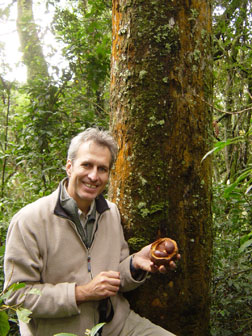
|
Forget:
I am a field naturalist working for the National Museum of Natural History (Muséum national d’Histoire naturelle, MNHN) in France. Though the main focus of my institution is taxonomy, my job as a teaching-scientist (Maître de conférences or Assistant Professor) at the Department of Ecology and Biodiversity Management (Département d’Ecologie et Gestion de la Biodiversité, DEGB) consists in contributing to a better understanding of the biology and conservation of tropical forests, as well as to teaching research methods to Masters and Ph D students.
Still, I may carry on plant inventories, and even recently discovered a previously unknown tree species in Guyana. We are currently describing it with colleagues at the Department of Systematics and Evolution at the MNHN. But my primary research area is to understand how a tropical rainforest functions and how biodiversity is maintained for millennia with or without anthropogenic pressures on fauna and flora. That means that my interests are quite broad, ranging from the complex and multiple relationships existing between plant and animals, to the recruitment and growth of forest plants — trees and palms in my case. For instance, I’ve been studying plant phenology (i.e. flowering and fruiting of some key commercial timber and non-timber forest species) and the ecological role invertebrates and vertebrates play either as dispersers and/or predators of seeds, for instance.
Though I’ve been mostly analyzing the importance of small and large neotropical rodents to plant life for more than two decades now, I am also fascinated and interested in describing relationships between plants and other animals such as primates, bats, birds or larger frugivores as Tapir or Elephants. I’ve also been studying seedling recruitment and their dynamics (survival and growth) for years, a decade or more since their establishment in the shade or in light.
But above all, my main concern is how to better use and conserve the tropical rainforest biodiversity without irremediably and negatively affecting plant recruitment and animal feeding and reproduction, in short, rainforest integrity and long-term persistence.
Mongabay: How did you become interested in the rainforest?
Forget:
In the sixties, I grew up with TV broadcasts and books by Commandant Jacques-Yves Cousteau. I also had an encyclopedia about wildlife fauna. During my youth, I always enjoyed walking and camping into the temperate forests thinking one day I’d like to work there, amongst the vegetation and wild fauna. My grandparents had a globe on their fridge, and I was always looking at it. When I was six years old my grandmother offered me an atlas which led me to dreaming of traveling to those exotic tropical countries.
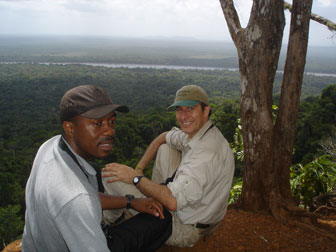 Dr. Pierre-Michel Forget with David Kenfack of the Missouri Botanical Gardens in Iwokrama, Guyana
|
I was very curious and questioning about natural history. No one was talking about deforestation or forest degradation at that time. I was contemplating and attracted by nature, maybe because I grew up in Paris suburban region. And as far I can remember, I always wanted to work with natural sciences and to understand how things work in the nature. For instance, at that age, I was already playing with oak seeds, and constructing 4-legged’ vertebrates with matches and Acorns. I had no idea that one day I’d play more seriously with tropical seeds, and that a number of other masting tree species and vertebrates would come to be so significant in my professional life (see Forget 1990, Forget et al. 2005).
When time has come to decide of my future job, I wanted to join the Office National des Forêts (ONF) to be a forestry engineer in order to work in temperate forests. But in France, to be a engineer or scientist at ONF, one needs to excel at secondary school, with very good scores in mathematics especially, which was not my case, and then pass high level courses to eventually enter the elite Ecole Nationale du Génie Rural des Eaux et Forêt (ENGREF). I was not ready to struggle that much, and because I was living in nearby Paris, I instead preferred to study biology at the University Pierre et Marie Curie (UPMC Paris VI), the top university in Science in France.
My interest for the tropical rainforest developed relatively late. I was an undergraduate student at the UPMC Paris VI. One of our teaching assistants, based at the Laboratory of Tropical Botany directed by the Professor Robert Schnell, who wrote books about the tropics in Africa and America, presented us the biology, diversity and morphology of tropical fruit and seeds. It was a real discovery, and I loved it. Several years earlier when I lived for several weeks in the bayous of Louisiana, I was initiated to subtropical regions, at least to the mosquito and the humid climate, but not to the botany. I was immunized and ready for more of both. I started to do research on tropical forests, and bought a book by Jan Jenik about the tropical ecology. But it was really during my third year at the UPMC Paris VI that I definitely decided that I wanted to study and work in the tropics.
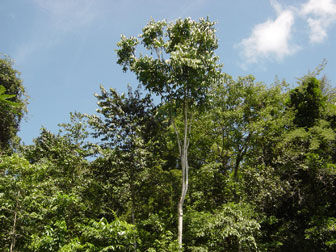
|
In the late seventies, it was the beginning of in-vitro culture and I was not that fond of laboratory work, preferring army-style field clothes and boots rather than a lab coat, gloves and protective glasses. So, whilst most of my colleagues were working on plant hormones or other physiology studies on palm oil or rose cell cultures, I instead proposed to prepare a review of rooting systems in the tropics.
That was the start of my career in that field. I asked Professor Henri Puig to advise me and be my godfather, and he accepted. I did well academically, though my only real experience of root systems was the buttressed and aerial roots of Cypress in the swamp of Louisiana. At least after four years, I was finally starting to study tropical trees. Then, everything accelerated. I started the year after a Master program in tropical biology at Puig’s laboratory at UPMC Paris VI. He asked me to work on a database on morphological characters of trees, root, bark and leaves from French Guiana to develop a field key for tree identification. It was the beginning of personal computer, and having met the late Jacques Lebbe and his future wife Régine Vignes (today Professor at UPMC Paris VI), I succeeded in developing the database in a large part thanks to their pioneering work on software that aided identification of taxon. We all published our first paper in a high-profile journal (Forget et al. 1986).
Meanwhile, in February 1984, we had a field course in French Guiana. I returned few months later for three months at Arataye forest, today known as the Nouragues Natural Reserve, with the research group of the MNHN directed by Professor Gérard Dubost, my mentor in the field of animal-plant relationships. Then, I started my Ph D Doctoral thesis with a grant from the French Government. As I worked on my thesis I became more aware of the increasing anthropogenic pressure on tropical rainforests and started to take an interest in forest conservation. As such I decided to focus my ecological studies on commercial timber so we would have a better understanding of what we need to do to protect them. By chance I again worked in French Guiana. I later spent a year as a post-doc fellow at the Smithsonian Tropical Research Institute in Panama, then returned to the Guianas where I have worked ever since. Recently, I’ve started to work in Africa, specifically Rwanda, to make ecological comparisons across continents as my predecessors did at the Museum in the 1960s and 1970s.
Mongabay: In general, what is the opinion of people in France about French Guiana?
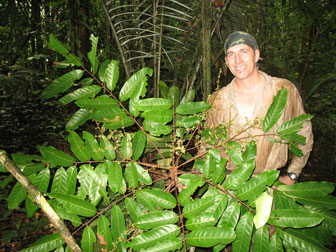 Dr. Forget and a fertile specimen of Carapa procera (photo by Scott Mori)
|
Forget:
When I said my grandfather in the early 80s that I was going to work in French Guiana, he warned me not to be sent to the jail. He was joking, but his generation and that of my parents only knew this overseas department from its dark history. It’s difficult to erase some images from the collective memory. To me, I started to know French Guiana from the good side, the forest, during my tropical course in Paris. Now, people in France mostly know it from another perspective, that of the space center and the Ariane launch site, and most of them are still ignorant about nature, especially the rainforest. They see it full of mosquitoes and as an unfriendly place. When you talk with people, they hardly believe you can enjoy walking in forest with all the insects, the heat and the humid conditions.
Despite efforts made by the regional authorities, French Guiana is not yet a developed tourist area compared to Martinique or Guadeloupe. It contrasts with Suriname where Dutch eco-tourists arrive weekly by the hundreds, and are filling hotels and field tours. It is a real rush to discover the rainforest, comparable to what we can see in Central America, in Costa Rica or Panama. French don’t travel as much as Dutch do. Thus, in my opinion, despite long history comparable to that of Suriname and the Netherlands, I think French people don’t know French Guiana, and are not really interested in it, at least not as much as in the Caribbean islands or La Réunion which are much more appealing to them for resorts and trekking. Today illegal mining and insecurity is undermining efforts to establish ecotourism in the country. Local authorities are doing little to address the situation despite repeated warnings.
Mongabay: If French Guiana were to become independent would it spell trouble for its rainforests?
Forget:
Let’s look at the situation of Suriname and Guyana that became independent 31 (1975) and 40 (1966) years ago, respectively. Decades later, they still have lot of rainforest, especially Suriname. Both countries have declared numerous national parks and reserves, such as the Suriname Central Natural reserve, a world heritage site of ancient rainforest that cover 1.6 million hectares. Today, both rely upon income from tourism from the Netherlands and the USA, as well as on the exploitation of bauxite, diamond, gold, bananas, rice, sugar cane, and logging.
Like French Guiana, these two countries still have small populations which are mostly located on the coast, far from the rainforest. Since gold and timber are not sustainable in the long term, if French Guiana became independent, I believe that it would have to focus on tourism which would require rainforest conservation. However, this might be difficult since the current subsidized economy under French control does not favor rainforest protection or conservation of natural resources and the French don’t have the same concern for conservation as the English or Dutch. Since French Guiana has few plantations, it seems likely that the rainforest will be rapidly exploited for wood and gold. Certainly, more roads will be built inland, which will trigger increased deforestation and it seems likely that independence would spur more poor Brazilian immigrants to enter the country illegally for mining and small-scale agriculture.
Mongabay: What is the current situation of forests in French Guiana?
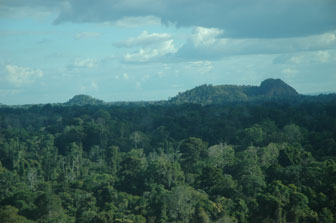
View of the Voltzberg at the Central Suriname Central Reserve (CSNR). The Coppename river at CSNR. Photos courtesy of Dr. Forget. |
Forget:
If one look at the rate of deforestation, all surveys (see mongabay.com) show that French Guiana has one of the lowest rates of forest loss in the world. This is due to efforts by the National Forest Office (ONF) to regulate forest use and limit the number of permits of exploitation to the coastal region as well as economic issues. Since France has high salaries and the government is unwilling to fund road projects into the interior, it is difficult to exploit most of the territory.
Today a greater threat comes from increasing illegal immigration from Brazil. Thousands of garimpeiros and their families, plus other Brazilian inhabitants who are often associated with mining camps (i.e. commerce, prostitution), are settling along rivers inland. Surveillance by ONF clearly shows that some 11,500 hectares of forest have been cleared in 2006 compared to about 200 hectares in 1990. What doesn’t show up in the survey is the thousands of kilometers of rivers that are directly or collaterally affected (pollution, mercury contamination, hunting) by mining activities, both legal and illegal. Above all, the pressure on wildlife is believed to be quite high. Though we lack data for the interior, it is likely that many areas are now threatened by such pressures that I encountered in the Brownsberg Natural Park in Suriname.
In the end, the people who will suffer most are the indigenous people of the region: the Wayana on western border (upper Maroni river) and the Oyampi on the eastern (Oyapock river upstream) frontier. We have seen violence in addition to river pollution and game and resource depletion. An ethnocide is under the way in the territory in the same year that we opened the new Museum of Humankind (http://www.quaibranly.fr/)
Mongabay: What’s the best way to protect rainforests?
Forget:
For sure, today, we should declare a large portion of the territory “National Park”, with a similar status as the neighboring “indigenous reserve” in Brazil. This is planned for next year, but under the new French National park law, gold mining will be authorized in the buffer zone, which now encompasses about all the western part of the future park. This is because people from French Guiana, mostly those from Maripasoula, wanted to be able to exploit alluvial gold there. This is nonsense to me and many of my colleagues at the Museum but nobody asked our opinion on the issue. We know what this means for the indigenous populations living upstream. We know that despite effort to regulate mining activities, clandestine mining will take place, simply because it is impossible to survey such a large territory. And, based on report from Venezuela, we also know that mercury (though forbidden since January 2006) will continue to be used by informal miners. Mercury poisons river and fish that are eaten by natives. Some entrepreneurs will follow guidelines, but most won’t according to data from other countries.
Disturbingly, this exploitation will likely spread into the new National Park. This serves as a terrible example for neighboring countries who are working to protect the rainforest: Brazil first, but also for smaller countries such as Suriname and Guyana. How can we, people from the North, ask them to protect their rainforest (to help avoid global warming) and offer them billions of dollars in exchange for carbon sequestration if we French don’t do the same in French Guiana. To me, it’s like saying that because we are rich we can destroy the rainforest and simply pay other countries to conserve theirs. It’s nonsense.
Mongabay: What is your long-term outlook for the forests of the Northern Amazon / Guiana Shield region?
Forget:
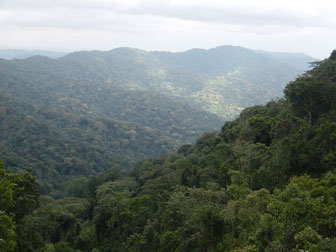 Largest remaining montane rainforest at Nyungwe National Park, Rwanda |
Honestly, if the State Government in Brazil continues to declare large area of rainforest as national treasure and create park after park as they recently have, I am quite optimistic that we will reverse the pessimist scenario of deforestation in the Amazon. As Stephen Jay Gould often argued, contingence is always possible and can radically affect scenarios. Today Brazil offers us a case of contingent behavior, which contradict earlier dire predictions and leads in a positive direction. But the future of Guianan rainforest will also depend on the economy of these countries. If we can help them, then I’m optimistic. People in the North should understand that we need to encourage these countries to protect their rainforest, and not systematically blame them when it is cut down. Often they have no other alternatives to survive, especially when driven by high market demand for gold and forest products.
We don’t really know how other governments in the region will respond to these threats in the near future. I can only hope these small countries in the Guiana Shield will follow Brazil’s lead, if they can from an economic standpoint.
However, I’m particularly concerned about a new threat to the rainforests of the Guiana Shield: China.
Recently I encountered a group of Chinese foresters who where invited to visit Guyana to evaluate its tropical wood potential, and now Guyana and China appear to be intensifying economic cooperation. China has cash and needs tropical wood. Guyana has tropical wood needs cash. It seems likely that Guyana will become a major source of wood for China’s development but it appears unlikely that China will worry much about the sustainability of timber harvesting unless the Government of Guyana mandates it. Guyana needs to find a good balance between getting income from eco-tourism and income from their natural resources. If adequate guidelines such as reduced impact logging are implemented and respected during the exploitation, as I saw in a Guyanese forest, then we can be optimistic. But sustainable harvest is not always the case.
Mongabay: What are the biggest threats in the area?
Forget:
After spending years studying in French Guiana, and few years recently in Guyana and Suriname, I will say that legal and illegal gold mining are the biggest threat to the rainforests of the Guianas along with over harvesting of fauna and pollution of rivers with mercury and sediment load.
Gold mining is tightly linked to the price of gold. Unfortunately, because of the international demand, especially from China, it doesn’t seem likely that gold prices are going to decline in the near future, and I am expecting an increase in mining activity in the Guiana Shield, across borders. Today, mining companies are forming in French Guiana to expand operations, and I am guessing they will want to explore the northern part of the future National Park which is so far exempt of (legal) activity, and still an ore-rich zone. The same will probably happen elsewhere in the Shield. In French Guiana, because the French government facilitates and subsidies the enterprise (reduced taxes on profits, gasoline, diesel, etc) in the overseas department, then mining is economically viable when it shouldn’t be for many entrepreneurs.
Mongabay: In academics do you see many students interested in pursing careers in science or are a lot of potential scientists being lost to technology and finance careers?
Forget:
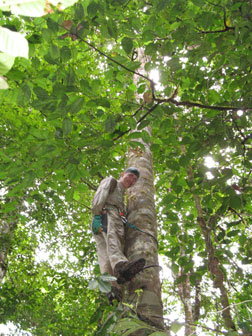 Dr. Pierre-Michel Forget climbing Carapa procera tree at Nouragues Nature Reserve, French Guiana (photo by Scott Mori) |
Overall, we are indeed losing students, but Science is still very attractive, especially when you look at tropical rainforest studies. I would say that it is very appealing now, especially regarding issues on biodiversity loss, global warming and the crucial need to protect the rainforest overall. Despite a lower number of demands, especially from the UPMC Paris VI to which I am linked, I still see a number of students who are willing to pursue career in the field of tropical forest ecology. I recruit biologists, but also veterinarians, forest engineers or agronomists, and that is a new phenomenon. And I am pleased that this new generation of high-profile students from High School is interested in rainforest ecology. They will be making the important decisions in the future, and they will know that forests are important to animals, and the latter is important for the former. When I was a young student, I remember that a famous forester in French Guiana was amazed to hear me explain how a commercial tree (Vouacapoua americana) was dependent on rodents for its dispersal and recruitment. Now, all young foresters who trained in French Guiana know that very well. We made a step forward. And ironically, as I originally wanted to work at ONF, I finally end having a student this year from the French Institute of Forestry, Agricultural and Environmental Engineering (ENGREF)!
Mongabay: In general, are people in France concerned about global warming?
Forget: Yes, they are definitely concerned now. We are experiencing the warmest winter on record. We see the results in our daily life, but I am not sure people are really aware that climate change will be far worse for people in tropical countries. I don’t think that people in Europe, North America, Japan, Australia, soon in India and China, realize that their behavior is going to affect the life of billions of poor people who will suffer more from drought and disease.
We still see the rainforest as a source of products. We need to stop and think about how these products (gold for our cell phone or computer, bauxite for our kitchen aluminum or cars, wood for our furniture, seeds for our shampoo or cream, ecotourism for our vacation) are derived from forests and the impact of their use on the world around us. We need to realize the importance of forests and now we can protect and preserve the rainforest, and contribute to planet-wide human welfare. It will take more time for people to acknowledge that our future climate will also depend on how much we help less-developed countries educate their citizens, produce and use clean energy, develop equitable markets and promote sustainable use of those natural resources. Regulation, fair market concepts, and ecological labeling are key to the effort. Otherwise, I don’t see how those countries will develop in a sustainable manner and avoid clearing all the rainforest for short-term income. The impact of such an outcome would have tragic consequences for biodiversity and the global climate.
Mongabay: What is you favorite place in the rainforest?
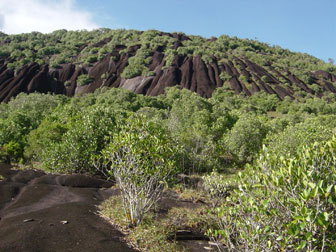 Photo of the Nouragues inselberg (peak), French Guiana |
Forget:
I really enjoy collecting specimens in the canopy, 20-30 meters above the ground. As terrestrial animals, the canopy is an exotic place to be, especially when a toucan or a spider monkey comes near you. But my favorite place is on the peak of Nouragues. It’s a granite outcrop from where I can sit and contemplate the almost infinite forest of French Guiana, unbroken all the way to Brazil. I like to walk there early in the morning, just after dawn, and stay a couple of hours watching sunrise, listening to the noise of the awakening forest, before it is too hot to stay longer. There, I watch the trees from above, as if I was flying, I think of my work, my relatives, and my friends, and I wish that many people will be able to see this landscape for many years. I am lucky to have the job at the Museum, and I am pleased to share knowledge and my enthusiasm for the rainforest with others, especially kids and teenagers.
Literature cited.
- Forget, P.-M., J. Lebbe, R. Vignes, H. Puig et M. Hideux. 1986. Microcomputer-aided identification: an application to trees from French Guiana. Botanical Journal of the Linnean Society 93: 205-223.
- Forget, P.-M. 1990. Seed-dispersal of Vouacapoua americana (Caesalpiniaceae) by caviomorph rodents in French Guiana. Journal of Tropical Ecology 6: 459-468.
- Forget, P.-M., Lambert, J. E., Hulme, P. E., et Vander Wall, S. B., 2005. (Eds). Seed fate: predation, dispersal and seedling establishment. CABI publishing, Wallingford.
Web sites.
